Text
Watch "Dr. John Hall - Satellite Surveillance (Project Camelot Radio) 1/11" on YouTube
youtube
#satellite surveillance#satellite terrorism#mind reading#gang stalking#mind hacking#trauma based mind control#workplace mobbing#neural rape#mental rape or influenced nightmares of rape#influenced synthetic dreams#physical body torture#rape#targeted in kentucky#military tactics#military technology#darpa#cointelpro#deiona marie muhmmad#Youtube
3 notes
·
View notes
Text
youtube
Gorgeous Ginger 4C Afro (ft. Maforsoon Natural Wig) Unboxing & Review
This is a wig unboxing and review. The unit is a Ginger Kinky Natural Fro that I received from the Maforsoon Store of Amazon.
.
In this video I will be unboxing and reviewing this unit.
.
If you are looking for a new do and want to check out, what I’m putting down, watch this video.
.
***
Contact email: [email protected]
.
PLEASE CLICK HERE IF YOU HAVE NOT SEEN THESE VIDEOS: 👇🏾👇🏾👇🏾
.
Gorgeous Ginger 4C Afro (ft. Maforsoon of Amazon Natural Wig) Unboxing & Review: https://youtu.be/s_9LHh1c5RA
.
This Wig is “Game On!” 22” Straight Human Hair Lace Front Wig - (ft. DDSNNT of Amazon): https://youtu.be/nu_8xbdxtBs
.
Products used for this video:
.
Featured Brands:
.
Brand: Maforsoon Store of Amazon
Material: Synthetic 70s Afro Wig
Texture: Curly
Hair Color: 30/33
.
Nails:
.
Sinful Colors Nail Polish Shade: Gogo Girl
.
Sally Hansen Salon Miracle Gel Top Coat
.
Beauty 360 Resurface Base Coat
.
Makeup:
.
Face
.
@Elfcosmetics Poreless Face Primer Shade: Clear
.
Fenty Beauty Pro Filt’r Setting Powder Shade: Hazelnut
.
Fenty Beauty Pro Filt’r Setting Powder Shade: Cashew
.
Fenty Beauty Pro Filt’r Setting Powder Shade: Banana
.
Fenty Beauty Pro Filt’r Hydrating Longwear Foundation Shade: 390
.
Fenty Beauty Sun Stalk’r Bronzer Shade: Mocha Mami
.
Milani Eye Pencil Shade: True Black
.
MAC Cosmetics Studio Finish Concealer Shade: NW45
.
Measurable Difference Blush Shade: Rose
.
ELF Cosmetics Poreless Putty Primer
.
Maybelline Master Chrome Metallic Highlighter Shade: 100 Molten Gold
.
Eyes
.
Fenty Beauty Sun Stalk’r Bronzer Shade: Mocha Mami
.
Ioni 3D Faux Mink Lashes 100% Hand Made Style: Wispy Natural Flare
.
@Lagirlcosmetics HD Pro.conceal Shade: Tawny
.
ELF Cosmetics Liquid Eyeliner Shade: Jet Black
.
Urban Decay 24/7 Glide-on Eye Pencil Shade: Zero
.
Cheeks
.
@MeasurableDifference Baked Face Blush Shade: Rose
.
Lips
.
MAC Cosmetics Lipstick Shade: Viva Glam Rhianna 2 Frost
.
LIKE & SUBSCRIBE on YouTube
https://www.youtube.com/channel/UCJESPzKbtGGTInUpoQLSX1g
.
Twitter
Www.Twitter.com/@Beauty_by_Tyy
.
Instagram
Http://www.Instagram.com/Beauty_by_Tyy
.
Pinterest
Http://www.Pinterest.com/Tyty4230
.
Facebook
www.Facebook.com/IamTyybo
.
Tumblr
https://beauty-by-tyy.tumblr.com
.
Tiktok
Http://www.Tiktok.com/@beauty_by_Tyy
.
.
.
.
#kinkywig #wigsforblackwomen #afro #wiglovers #fulllacewig #shorthairstyle #sista #dramaticmakeup #shorthairdontcare #fentybeauty #fypage #wigcollaboration #lacefront #lacefrontal #lacefrontwig #lacefrontalwigs #makeupguru #naturallips #teamnatural #naturalhairdaily #naturalhairstyles #naturalhairrocks #naturalhairdreams
#blackbeautyinfluencer #blackmakeupartist #lacefrontwigs #lacefrontwigsale #lacefrontwigsforblackwomen
#kinky wig#wigs for black women#Afro#short hair styles#short hair don’t care#lace frontal wigs#natural hair dreams#black beauty influencer#makeup guru#team natural#wig lovers#synthetic natural wig#amazon review#Amazon collab#wig collab#youtuber#youtube wig review#youtube videos#black makeup artist#fenty beauty#Mac Cosmetics#Ioni cosmetics#mink lashes#Youtube
0 notes
Text
People frequently talk about the presence of a dragon in Sleeping Beauty - wondering if it is was the Disney movie that invented this concept, if there were cultural precedents to it, or what were Disney's influences if any they were.
Well here's a little piece to add to the puzzle if you want: there was a famous French adaptation of Sleeping Beauty where the prince had to fight a dragon to wake up the Beauty. Well, it was famous back then, today most people don't know about it, but it still is an important piece of fiction because it is tied to someone everybody still knows today: Sarah Bernhardt
Sarah Bernhardt, THE great and famous theater actress of France, the one and only super-star of the second half of the 19th century/early 20th century. She acted as the main actress and stage director of a Sleeping Beauty adaptation that was created in 1907 in her theater: "La Belle au bois dormant" by Jean Richepin and Henri Cain (a duo who had previously worked on Massenet's Cendrillon stage adaptation). This play (a "féerie lyrique" in verse, one prologue, two parts, fourteen tableaux ; all in alexandrins but switching between singing parts and talking parts) was a HUGE success of the time, beloved by both the audience and the critics (Sarah Bernhardt's presence certainly did help, as anything she was in was bound to be a success). It was remember as one of this works that tried and managed to bring a "féerie totale", this desire to create a féerie show where the literary aspect would be just as important and powerful as the musical and theatrical aspects.
In fact, this is what has been doing the success of the play, as some people analyzed: it both spoke to the audience who was in need of huge marvels and powerful supernatural on stage, desiring big-budget "féerie" shows (the play had TONS of singers, dancers, actors, etc, and the sets and props were done by famous craftsmen of the time) ; and to a certain part of people who were complaining that shows were becoming purely "visual" entertainment and "ocular" performances without any actual quality writing or literary effort in there. This show was both a big-budget special-effect feast, AND an effort at being a literary and cultured creation (it gathered and synthetized the many stage-adaptations of Sleeping Beauty of the 19th century - as it had been frequently adapted in theaters - with references to Shakespeare, La Fontaine, Banville and more... (Some have pointed out how the over-saturation of tropes, references and inspirations might have played a part in the show being forgotten, because once Bernhardt was out, it felt like a kitch performance mixing too-obscure references with a superficial fairytale melting pot... anyway).
The prince in this play (played by Sarah Bernhardt herself, since she adored playing "cross-dressing" roles) doesn't just cross the briar forest, he actually has to face three different trials (people have noted an influence of Wagner's creation in the sequence, like his Siegfried and Parsifal). And the first of these trials is a huge dragon. It is the eighth tableau: in "le bois des épouvantes" (the wood of terrors), under loud thunder, in the "half-day of a sinister and greenish twilight"), the prince fights and kills a fire-spitting dragon (later the text evokes a "green dragon spitting red fire", seemingly continuing from the visual color clash).
If you are curious about the other trials, the prince then is literaly englued in a soporific darkness (it is compared to pitch and glue), and as he falls asleep a Demoness/Enchantress appears. She tries to distract him away from his quest by invoking "nymphs with bodies of flowers" and "nymphs with bodies of flames", who perform a flower-fire lascivious ballet representing the "venomous wine-dreams" they send the prince, the Enchantress trying to snatch a kiss from him - but the prince shakes off the lustful illusions and the demoness and her nymphs disappear.
The last trial is at "le lac de désespérance" (the lake of despair - or rather "the lake of despairing"). There, he encounters grey, aetherial women formed out of the mists and fogs over the lake - they are alternatively called "undines" and "the sirens of oblivion", and they perform a sorrowful, sad and haunting melody, with a song about despair, death and eternal rest, inviting the prince to... well to suicide. But the prince refuses the call, refuses to get in the water. The undines disappear in the fog - and when the mist gets away, the Sleeping Beauty's castle is revealed in the light of dawn. The prince then just walks on the waters of the lake like some sort of new Jesus, to go save the princess...





#sleeping beauty#la belle au bois dormant#sarah bernhardt#french things#la belle au bois dormant 1907#sleeping beauty adaptations#dragons in fairytales
11 notes
·
View notes
Text
Cultural Exchange
@flufftober
Flufftober Day 4: Zaeed Massani/female Shepard Cinderella Moment
"Some women find facial scars attractive. Mind you, most of those krogan are women." In which I take Garrus' line from ME2 after taking a rocket to the face and use it as the basis for krogan attraction as a culture, then explore how that would influence their perception of Zaeed Massani.
Not in a million years did Zaeed ever think he'd end up on Tuchanka. Then again, ever since accepting the contract from Cerberus, he'd been places and done things he never could've even dreamed of. So honestly, going to the krogan homeworld to visit the current clan leader should just be par for the course at this point. Considering they were meeting with Urdnot Wrex, one of Shepard's old squadmates from chasing Saren, he'd been surprised when she told him to suit up instead of Garrus or Tali. Nevertheless, when the Commander asked him to go somewhere, Zaeed followed.
Considering how rarely humans went to Tuchanka -if they'd even ever been there before- Zaeed was expecting to get more than a few looks. What he was not expecting was to get double takes and blatant once or twice overs. Grunt and Shepard were getting their fair share of looks too, but Zaeed was the only one getting stares. It was guddamn unsettling is what it was. None of the stares seemed to hold any malice, but Zaeed made his living by flying under the radar. So much direct attention burrowed under his skin and set fire to his nerves. Phantom pain prickled out from the edges of his synthetic skin grafts. Trying to remain as nonchalant as possible about it, Zaeed shifted his hands closer to the weapons strapped to his person. Shepard, by contrast, seemed more at ease than he'd ever seen her, even moreso than on Illium.
One of a kind, that woman.
Grunt, for his part, had an air of superiority about him that seemed to be setting other krogans on edge. If they made if off Tuchanka without a fight, it'd be a miracle. Hell, if they made it to see Shepard's old squadmate without someone getting decked, Zaeed would be surprised. It wasn't that they were looking for a fight, but with whatever was going on with Grunt and Shepard never one to back down, the odds of violence were significantly higher than zero. Fortunately, they made it to Urdnot Wrex's throne with minimal incident.
The reunion between the krogan leader and the Commander was far warmer than Zaeed would have ever guessed. The two had clearly bonded while hunting for Saren, easy affection on display. Wrex looked at Shepard with almost fatherly pride, and she seemed like a kid whose parents just got back from a long trip. As Shepard introduced the clan leader to her companions, Zaeed nearly sneered when Wrex's eyes lingered on him, giving him a once over. The once over didn't feel malicious, but the mercenary's nerves were on edege from all the looks and being in the center of so much attention. Strangely enough, the once over felt similar to ones he'd received from women and a few men in bars before Vido blew half his face off.
Wrex turned back to Shepard and chuckled. "Damn Shepard, of course you of all people would manage to find the one human that's actually good looking."
The gears in Zaeed's brain ground to a halt. Good looking? Him?
By necessity, he was not a vain man. Although he'd been considered handsome when he was younger, Vido had made sure that was never the case for the rest of Zaeed's life. While in the grand scheme of things, his appearance wasn't nearly as important as his life. Mercenaries didn't need to look pretty to get the job done. Still, it hurt the way people couldn't quite meet his eyes or would try and ogle him from the corner of their eyes while trying to be subtle about it. Mirrors were something Zaeed actively avoided for years after the incident with Vido, to the point where it was still a habit even now. So for anyone, even a krogan, to find him good looking? Well, he didn't have any idea about what to do with that.
Shepard grinned broadly at Wrex, but there was something softer to it Zaeed didn't want to think about as her gaze slid over to meet his eyes. "Didn't I just? It's nice having someone around who's good with a gun and a pretty face. That combination is so much harder to come by than you'd think."
Wrex roared with laughter. Meanwhile, Zaeed was fairly certain the rubble under him just experienced a landslide. A pretty face? Him? Shepard, one of the most beautiful, incredible, competent women he'd ever met thought his scarred, damaged face was pretty? There was no teasing to her tone, and while the commander could poke fun, she would never be cruel enough to joke about something like this. She meant it. Zaeed couldn't even begin to consider the implications of Shepard thinking he had a pretty face and giving him a soft smile, one he was now realizing had only ever been directed at him. While Zaeed tried to keep himself from fullblown spiraling, Wrex clapped Shepard on the shoulder.
"You really are part krogan, Shepard, you know that? You get that there's nothing sexier than some good scars."
So that's why Zaeed had been getting so many stares earlier. He'd forgotten about that particularity of krogan culture. Unexpectedly, a ball of warmth settled in his stomach before spreading out to the rest of him. Maybe most of the galaxy would always find his scars ugly and repulsive, rather than a sign of everything he had survived and endured. If that's how it was going to thing, so be it.
But at least here, amongst the krogan, Shepard's people in spirit if not blood -and weren't the implications of that just something to deal with another day- Zaeed was beautiful.
#zaeed massani x shepard#zaeed x shepard#flufftober2023#day 4#mass effect#my writing#zaeed massani#shepard x zaeed#shepard x zaeed massani
17 notes
·
View notes
Photo

Blade runner poster framed Molding:Professional 1" Flat Top Black (solid-wood) Matte: 100% acid free board, Print: Full Color dry mounted glossy print Glass is included, Comes Fully Assembled Ready For Your Wall The double mat adds depth giving the display a unique "looking through a window'' appearance. The calendar print is bonded to foam core on a hot vacuum press. This bonding gives the print a perfect flat and smooth texture. This process also insures the print will never fold or fade with age or moisture. This wonderful display makes a thoughtful and original gift containing a classic vintage touch yet modern design, allowing it to fit alongside both modern and classic decor. BUY WITH CONFIDENCE. ALL OF MY DELICATE ITEMS ARE SHIPPED WITH A SPECIAL 3 LAYER PROTECTION SYSTEM. Blade Runner is a 1982 science fiction film directed by Ridley Scott from a screenplay by Hampton Fancher and David Peoples.[7][8] Starring Harrison Ford, Rutger Hauer, Sean Young, and Edward James Olmos, it is an adaptation of Philip K. Dick's 1968 novel Do Androids Dream of Electric Sheep? The film is set in a dystopian future Los Angeles of 2019, in which synthetic humans known as replicants are bio-engineered by the powerful Tyrell Corporation to work on space colonies. When a fugitive group of advanced replicants led by Roy Batty (Hauer) escapes back to Earth, burnt-out cop Rick Deckard (Ford) reluctantly agrees to hunt them down. Blade Runner initially underperformed in North American theaters and polarized critics; some praised its thematic complexity and visuals, while others critiqued its slow pacing and lack of action. The film's soundtrack, composed by Vangelis, was nominated in 1982 for a BAFTA and a Golden Globe as best original score. Blade Runner later became a cult film, and has since come to be regarded as one of the greatest science fiction films. Hailed for its production design depicting a high-tech but decaying future, the film is often regarded as both a leading example of neo-noir cinema and a foundational work of the cyberpunk[9] genre. It has influenced many science fiction films, video games, anime, and television series. It also brought the work of Dick to Hollywood's attention and led to several film adaptations of his works. In 1993, it was selected for preservation in the National Film Registry by the Library of Congress.
#nerd gift#sci fi decor#robots#blade runner#harrison ford#cyberpunk#cyber punk#futurism#cyberpunk poster#cyberpunk gift#science fiction gift#wall art
2 notes
·
View notes
Text
Signalis
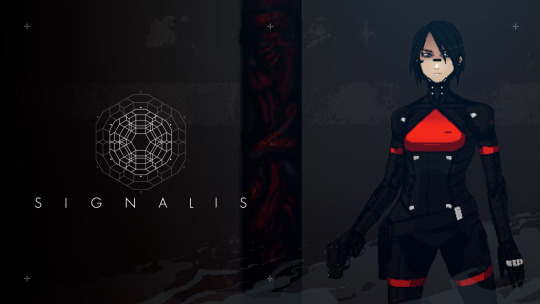
Signalis is a survival horror game that blends classic horror elements with a striking retro-futuristic aesthetic and deep, psychological storytelling. Set in a dystopian future where android-like machines called Replikas serve humanity, the game follows a Replika named Elster as she embarks on a journey through a desolate, mysterious facility to find her lost partner. Inspired by survival horror classics like Silent Hill and Resident Evil, Signalis offers a chilling, atmospheric experience with a complex narrative that delves into themes of identity, memory, and existential dread.
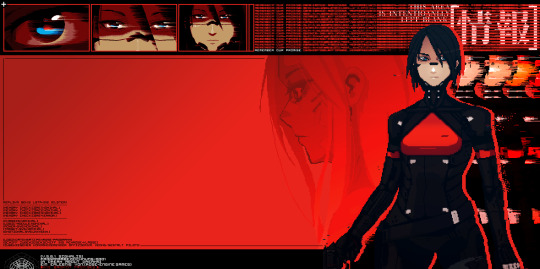
The story begins with Elster, a Replika unit, awakening on a crashed spaceship on an icy, alien planet. She embarks on a search for her partner, Ariane, venturing into a dark, abandoned research facility. The facility is filled with hostile, malfunctioning Replikas and strange, nightmarish creatures, as well as cryptic notes and clues that hint at something more sinister beneath the surface.
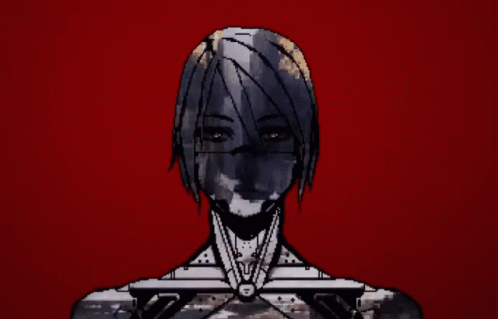
As Elster progresses, the game weaves together flashbacks, memories, and surreal dream sequences, gradually revealing the true nature of her mission, the facility's purpose, and the emotional connection between her and Ariane. The narrative is told through fragmented storytelling, leaving much of the interpretation up to the player, but touching on themes of human emotion, the limits of synthetic life, and the consequences of experimentation gone wrong.
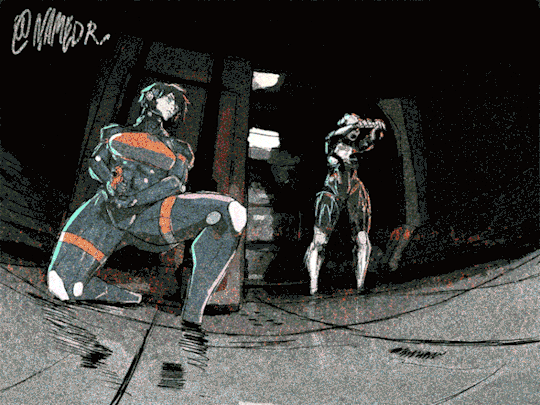
Signalis embraces the core mechanics of classic survival horror. Players must manage limited resources such as ammunition, health items, and inventory space, which are critical for survival. Combat is deliberately slow and strategic, with Elster needing to carefully aim and conserve bullets while dealing with dangerous enemies. Puzzle-solving is also a major aspect, with cryptic notes, environmental clues, and intricate lock systems that echo the genre’s roots in exploration and problem-solving. The tension is maintained through tight resource management and an overwhelming sense of vulnerability.
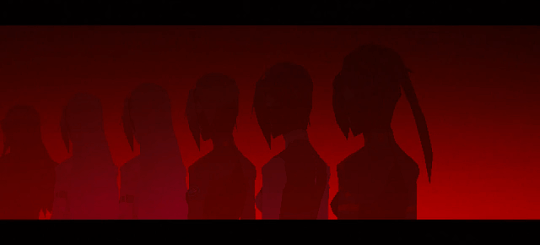
The game's visual design is one of its standout features. Signalis employs a retro-futuristic, pixel-art style that draws heavily from early PlayStation-era graphics, while mixing in modern lighting effects and sharp, detailed environments. The aesthetic combines sci-fi elements with brutalist architecture and cold, industrial spaces, evoking a feeling of isolation and unease. The art direction enhances the claustrophobic, oppressive atmosphere, blending a 1980s-style vision of the future with an eerie, dystopian setting.
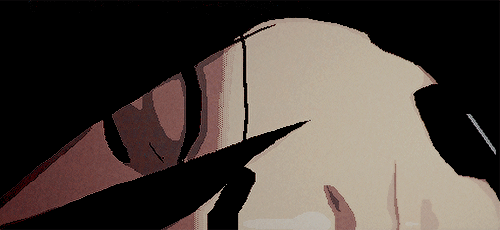
The storytelling in Signalis is subtle and often abstract. Instead of straightforward exposition, the game relies on environmental storytelling, cryptic notes, and disturbing imagery to convey its narrative. Players must piece together the fragmented story, much of which is left open to interpretation. This approach creates a sense of mystery and encourages replayability, as each playthrough can reveal new layers of meaning. The atmosphere is thick with dread, with haunting sound design and a minimalist, unnerving soundtrack that amplifies the feeling of isolation and danger.
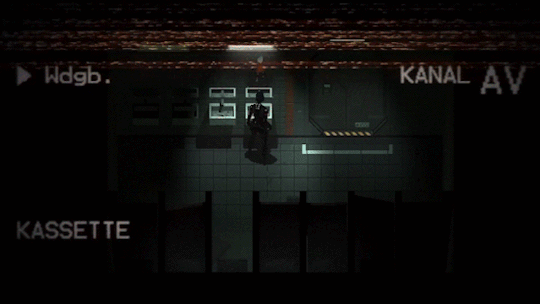
Signalis wears its influences proudly, drawing from a variety of sources in both gaming and literature. It takes heavy inspiration from survival horror classics like Resident Evil and Silent Hill, with fixed camera angles, resource scarcity, and puzzle-solving at its core. Thematically, it also borrows from sci-fi horror works such as Ghost in the Shell and Blade Runner, blending the concepts of synthetic life, memory, and dystopian futures. There are also nods to the works of H.P. Lovecraft, particularly in the way the game handles themes of cosmic horror and the unknowable.
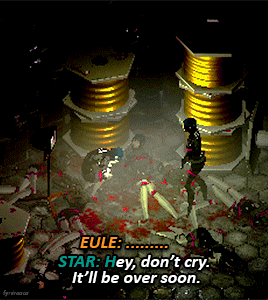
Signalis is a masterful blend of classic survival horror mechanics and deeply psychological, atmospheric storytelling. Its retro-futuristic aesthetic, combined with a chilling narrative that explores themes of memory, identity, and the human condition, sets it apart as a unique entry in the horror genre. For fans of survival horror, it offers a nostalgic yet fresh experience, with intense combat, intricate puzzles, and a hauntingly mysterious world to uncover. Signalis successfully captures the essence of classic horror games while adding its own emotional and psychological depth, making it a must-play for fans of the genre.
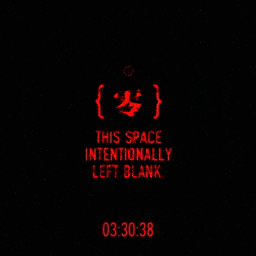
Written by Angie Ramirez
2 notes
·
View notes
Text

Alien: Romulus
R 2024 ‧ Horror/Sci-fi ‧ 1h 59m
Cue the lo-fi beats and the vintage VHS effects
We finally got another one, Boys. whats up back at it again with another film review. Let's dive into the spooky, squishy spacey nightmare that is Alien romcom I mean Alien: Romulus. Which by the way likely references the mythological figure Romulus, the legendary founder of Rome. Romulus, along with his twin brother Remus, is a symbol of origin, survival, and the violent birth of a new order. This connection may suggest themes of beginnings, foundation, and perhaps the brutal conditions under which new civilizations (or in this case, new forms of horror) arise. In the context of the Alien universe, the name "Romulus"
could metaphorically relate to the birth of something terrifying and foundational within the series' lore, possibly marking a return to the franchise's origins while introducing a new chapter or entity that carries a significant impact. It may also imply the creation or discovery of something that, like Romulus's Rome, is destined to grow into something powerful and enduring—albeit with a dark and violent genesis. These mythological and thematic parallels could be why the filmmakers chose the name "Romulus" for this installment and keeping up the tradition of Greek names. Like Prometheus.
Did they bring back the xenomorphs? yeah, they did it—they brought back them back along with
the face-huggers, and all the existential dread you could ever want, but... did they stick the landing? Let’s find out. First off, this movie is like if you took the OG Alien and Aliens, shoved 'em in a blender with some VHS tapes of Blade Runner and a sprinkling of your favorite 80s horror flicks. It takes the formula and runs with it. A horror film with Teens in space. It’s as if you gave people from the original alien and aliens films and gave them updated film equipmentment and said go crazy. Pays homage and fan service in a respectful way.
Fede Álvarez, the guy who brought us that Evil Dead remake, knows how to make you squirm in your seat, and here, he’s playing all the right notes—just maybe a little too close to the originals at times. Set between the events of the original Alien (1979) and Aliens (1986), the film is praised for capturing the claustrophobic terror that defined the early films. A Classic troupe in horror is isolation, one of the most isolated places in existence, space, prefect. The plot centers on a group of young people who, in a desperate bid to escape their grim existence on a mining colony, board an abandoned spaceship, only to encounter the deadly xenomorphs.
The film's atmosphere is heavily influenced by the classic haunted-house-in-space formula that made the original so effective. The production design and practical effects are especially noteworthy, with a deliberate move away from heavy CGI in favor of tangible, lived-in environments that heighten the tension and realism. This return to practical effects is a major point of praise, as it creates a more immersive and terrifying experience for the audience.
We’re talking practical effects that look like they’ve crawled out of a Ridley Scott fever dream. There’s some seriously gnarly creature design here, and the space station where our unlucky crew of Gen Z miners end up feels more lived-in than my old room full of N64 games. There’s a real effort to make the environment feel gritty, grimy, and full of history—like people lived and died here long before our crew showed up and made bad decisions. And yeah, they make some real bad decisions.
Let’s talk characters. We’ve got Cailee Spaeny as Rain, who’s basically the 2024 answer to Sigourney Weaver's Ripley. She’s tough, but forgettable . She’s just trying to survive, and honestly, who wouldn’t be? But the real star here is David Jonsson as Andy, the synthetic. This dude’s playing mind games with everyone, including us. Half the time, I didn’t know whether to root for him or be freaked out. And honestly, that’s how you know he’s nailing it. There isn't specific information available that confirms whether the character Andy is explicitly portrayed as autistic. However, characters who are synthetics or androids in the Alien franchise often display traits that could be interpreted as being on the autism spectrum, such as difficulty with social interactions, a focus on logic and tasks, and a unique way of perceiving and processing the world around them. David Jonsson's portrayal of Andy is noted for its complexity, making the character intriguing and enigmatic, with audiences unsure whether to fear or sympathize with him . This ambiguity might lead to different interpretations, including one where Andy's behavior could be seen through the lens of neurodiversity, but without clear confirmation from the filmmakers, any conclusions would be speculative.
Another noteworthy observation is his portrayal has interesting layers when you consider his race. In science fiction, synthetics often represent "the other"—beings that are created, owned, and often exploited by humans, drawing parallels to historical and ongoing issues of slavery and racism. By casting a Black actor as Andy, the film may subtly invoke these themes, whether intentionally or not. The parallels between Andy's existence as a synthetic and the historical treatment of Black people as property or slaves add a deeper layer to his character. Synthetics in the Alien franchise often grapple with questions of autonomy, identity, and purpose, much like how marginalized groups have historically fought for recognition and rights. Moreover, Andy’s struggle with his programmed directives and the way he is perceived by others could reflect the societal prejudices faced by Black people, who are often judged and constrained by societal expectations and biases. This interpretation suggests that Andy's character might be seen as a commentary on the intersection of race, identity, and humanity's fear of "the other."However, these themes are likely more interpretive than explicit, as the film does not overtly address race. Still, the casting of David Jonsson as Andy adds a significant layer of complexity that invites viewers to explore these possible connections.
But okay, this movie’s not perfect. The audio mixing? Yikes. It’s like they recorded the first 30 minutes in a wind tunnel or something. I couldn’t make out half the exposition, which is kind of important when you’re dealing with a plot and also the accents are kind of hard to understand without subtitles, but hey I understand why our boy Ridley Scott, is British and since he is producing the film with his company Scott Free why not? Don’t even get me started on the CGI resurrection of Ian Holm’s character from the first Alien. They tried to go for that sweet fan service, but it just ends up looking like something from a creepy deepfake video.
That said, if you’re into that old-school, haunted-house-in-space vibe, Romulus delivers. It’s got the thrills, the chills, and enough gooey body horror to make you question your life choices. It’s like watching your favorite horror franchise come back to life, but this time with a bit more self-awareness. The plot might be thinner than my hairline, but sometimes you just want to see some aliens eat people, you know?
In the end, Alien: Romulus isn’t here to revolutionize the franchise—it’s more like a greatest hits album with a few new tracks. And honestly, I’m okay with that. Now, if you’ll excuse me, I’m gonna go re-watch the original and remind myself why I never want to go to space. Catch you later, space cowboys.
Subjective 7.9/10
Objective 7.5/10
3 notes
·
View notes
Text
Stigmatic Herald (Demon-Beast Crossover)
Andrew Miller has seen a lot of shit after over three decades of life as a stigmatic. He’s met most of the other things lurking in London’s shadows, been a part of nearly a dozen cults, murdered Unchained, fought alongside Agencies he’d previously tried to kill and made a name for himself among mortal occultists who have no idea what else is out there. He has one unshakable belief that guides everything he does: the conviction that the God-Machine is broken.
Andrew’s first encounter with the supernatural had actually been with the Begotten, although exposure to the God-Machine’s gears is what ensured his life would never be normal. As far as Andrew figures, there isn’t a good reason for demons and angels to be so antithetical to Beasts. They are both occult forces, and while grounded in different principles, Andrew ultimately believes in a unified reality. His hypothesis is that the God-Machine is out of sync with the rest of the occult universe, which is why Beasts react poorly to it and is the cause for its seemingly contradictory directives. It has taken years of preparation, but he feels he is finally in a position to do something about it.
Andrew wormed his way into the good graces of Ida Max, an Inguma Tyrant whose Horror reflected the fear of impossibly human-like machines. Andrew pushed Ida towards expanding her Lair and Legend in ways reflecting technology and machinery. While Ida couldn't develop Family Ties with the Unchained or the God-Machine’s angels, Andrew helped her forge bonds with other stigmatics, psychics, and stranger beings touched by the God-Machine. When Ida created her cult, Andrew became her Herald and began executing his plan. While Ida is more physically powerful than Andrew, he knows how to run a cult while making her feel like she is in control.
Now, Andrew is in the final phases of his plan. He’s started pushing Ida towards Inheritance, and while he’d prefer she become an Incarnate, an Unfettered or Rampart would also serve his purposes. As much as Andrew genuinely appreciates Ida, she has always been a means to an end for him. If he must sacrifice her to heal God, so be it.
If Andrew could still pass as an ordinary human, he’d look plain. Messy black hair, a body that’s gone slightly to seed, and a face that refuses to stand out all help blend in with a crowd. They also disguise his powerful, magnetic personality. When Andrew talks, he makes you believe whatever he is saying, regardless of how far-fetched it sounds. Between his stigmata and Ida’s influence over her Herald, Andrew lands solidly within the uncanny valley these days. His skin is slightly matte and rubbery, giving those who look at it the impression it is synthetic rather than organic. The veins under his skin are silvery rather than blue, appearing far more like circuitry than a circulatory system. His voice is distorted and synthetic like it is coming through a bad radio or an autotuner that’s gone too far.
Legend: Relentless Life: Selfless Aspirations: Recruit new cultists, Convince Ida to undergo Inheritance, Fix the God-Machine Attributes: Intelligence 4, Wits 3, Resolve 3; Strength 2, Dexterity 2, Stamina 2; Presence 4, Manipulation 5, Composure 2 Skills: Academics 1 (Religion), Computers 4, Crafts 4, Occult 3 (Cults), Politics 2, Science 2; Drive 2, Firearms 2, Larceny 1; Empathy 3 (Emotional Weaknesses), Intimidation 1, Persuasion 4, Socialize 2, Streetwise 2, Subterfuge 5 Merits: Anonymity 1, Aura Reading, Eidetic Memory (Advanced), Fast Reflexes 3 (Advanced), Omen Sensitivity, Unseen Sense (God-Machine), Unseen Sense (Primordial Dream) Health: 7 Willpower: 5 Integrity: 4 Size: 5 Speed: 9 Defence: 2 Initiative: +7 (include Fast Reflexes)
10 notes
·
View notes
Text
Welcome back to Dark Brandon's daily update!! So I heard through the grapevine that three of our so-called 'allies' are deciding to recognize Palestinian sovereignty. They clearly don't understand that our job as politicians with international influence is to say we care about the lives of everyone while continuing to support our long-term allies despite their genocidal tendencies. It astounds me that famous victims of oppression and military occupation the Irish would choose to support a nation- crap, I mean a people whose situation closely mirrors their past experiences with the British. The compassion of the people of Norway, Spain, and Ireland is sickening to me, as they clearly have no regard for the feelings of the pseudo-synthetic apartheidist state led by a man whose own bigotry outweighs any chance for peace in the region. The fact that Isreal's glorious leader, Netanyahu, is under investigation by the International Court of Justice makes me deeply concerned for the fate of this alliance we have forged with a nation created for victims of oppression to isolate further and take their anger out on innocent civilians who have done nothing to cause their previous plight. Without Isreal riding on our cock, how can we continue to project Western power across the worn-torn Middle East for our own sick dream of global control and 'peace'? I only hope that the IDF can kill every Palestinian- I mean Hamas member before this situation can get out of control. Did you know that a large amount of my voter base despises my decisions? I might just nuke Gaza so that no more human rights abuses can occur (can't violate dead humans' rights.) Have a great day, gang, and remember, gaslight gatekeep girlboss!
4 notes
·
View notes
Text
Five Nights at Freddy's: The Untold Story/Five Nights at Freddy's (Movie Review) (Masterlist)
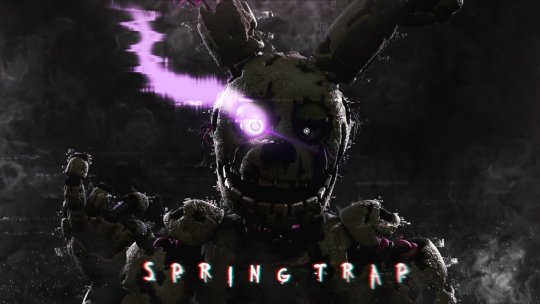
A tetralogy which encompasses the following stories: Five Nights at Freddy's: Masterpiece, Five Nights at Freddy's: Salvaged, Five Nights at Freddy's: Nothing Remains & Five Nights at Freddy's: Obsolete. Taking place after the events of Pizzeria Simulator, it features William Afton/Springtrap's return and confrontation with his past decisions, the people involved in the tragedy he caused and his influence over the events of Help Wanted and Security Breach.
Five Nights at Freddy’s: Masterpiece
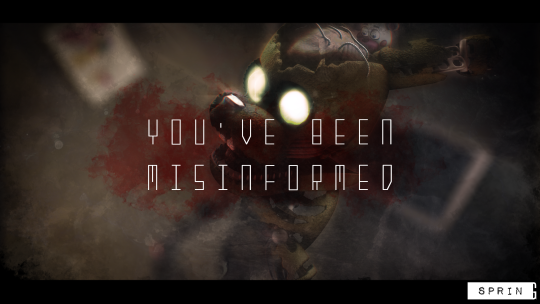
Who are we, Henry? Do you understand what we have created? What I have created? There are so many questions that need to be answered, old friend. However, unlike you, I am not afraid of the consequences of my choices.
Night 0: Masterpiece
Five Nights at Freddy’s: Salvaged
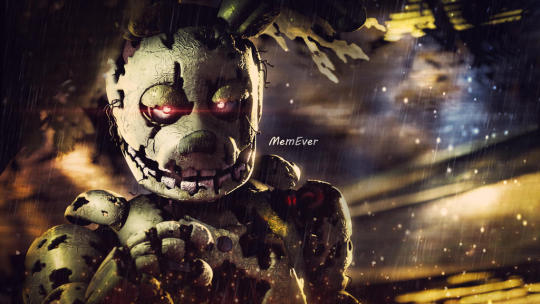
Even after escaping Hell, William is still haunted by his past. Back as Springtrap, he's forced to confront his past self, accepting either atonement or annihilation. To his surprise, he gains unexpected assistance from Sam, who is investigating the rumors surrounding the new Fazbear location…
Chapters
Night 0: Undone
Night 1: Replay Your Nightmare
Night 2: Salvaged
Night 3: Visit The Past
Night 4: You’re Not Alone
Night 5: Our Little Horror Story
Night 6: It's Never Satisfied
Night 7: Obsolete
Night 8: Carry On
Night 9: Salvage Dreams
Night 10: Can't Get Away
Night 11: Disconnected
Night 12: Just An Attraction
Night 13: It's Time To Die
Night 14: All Is Hell
Night 15: Under Lock And Key
Night 16: My Curse
Night 17: Not Here All Night
Night 18: Lockdown
Night 19: Is It Something Out There?
Night 20: Left Behind
Night 21: I Can't Fix You
Night 22: Machinations
Night 23: Not The End
Night 24: The Big Bad Wolf
Night 25: Circus Of The Dead
Night 26: Bad Dream
Night 27: I'm Still Alive
Night 28: Dream Your Dream
Night 29: Spring-Loaded Trap
Night 30: The Hunt
Night 31: The Story's Not Over Yet
Night 32: Freddy's Horror Show
Night 33: It's Been So Long
Night 34: Madness
Night 35: Mechanical Instinct
Night 36: The Monsters I've Created
Five Nights at Freddy's: Nothing Remains
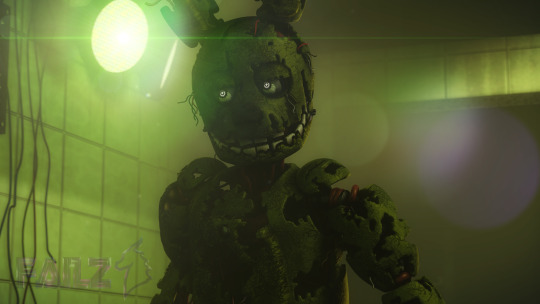
William Afton, as Springtrap, is enjoying his life as Sam's best friend and father figure. However, as they explore the recently opened Freddy's location, not only are the ghost of his past preventing him from finding redemption, but are also seeking complete annihilation of his mind and soul, until nothing has remained of him…
Night 0: Searching For The End
Night 1: We Will Always Be Together
Night 2: Welcome To Freddy's
Night 3: After Show
Night 4: Haunting My Dreams
Night 5: Remains
Night 6: Instruments Of Nightmares
Night 7: They're Calling My Name
Night 8: Awaiting My Fate
Night 9: After Hours
Night 10: Like It Or Not
Night 11: The Demon Inside Me
Night 12: Just Sleep, Just Dream
Night 13: My Deeds Sent Me Too Far
Night 14: Dead But Not Buried
Night 15: The Clock Ticks
Night 16: Beware Of Us
Night 17: All Inside My Head
Night 18: Follow Me
Night 19: Make Your Move
Night 20: Unfixable
Night 21: Defects
Night 22: Showtime
Night 23: They Rise
Night 24: Living In A Memory
Night 25: Outcast
Night 26: Synthetic Agony
Night 27: An Ill Omen
Night 28: We Know The Ending
Night 29: Connection Terminated
Night 30: Nothing Remains
Night 31: Shattered
Five Nights at Freddy's: Obsolete
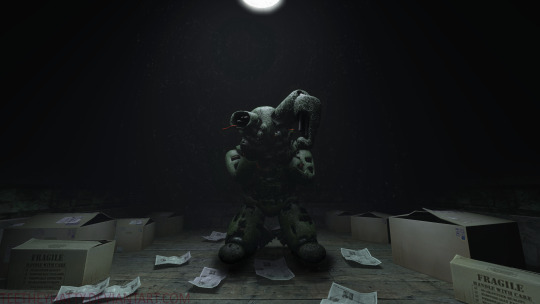
This was his final performance and he knew that he wouldn't return. Still, the glitch he had created remained, forcing William Afton, alias Springtrap, to confront what he had left behind. Even Sam is troubled by his return, aware that, beside her, there is another person who decided to carry on his murderous legacy…
Night 0: The Final Bow
Night 1: Thanks For The Memories
Night 2: Darkest Desire
Night 3: We're Not Monsters
Night 4: Help Wanted
Night 5: Can You Hear Me?
Night 6: Picking Up The Pieces
Night 7: Under Construction
Night 8: Hallucinations
Night 9: Haunted Reality
Night 10: Into The Pit
Night 11: Stay The Course
Night 12: Such Sweet Sorrow
Night 13: The Show Has Just Begun
Night 14: The Game Continues
Night 15: Rewind The Memories
Night 16: Secrets That You Keep
Night 17: The Storyteller
Night 18: Freddy Fazbear's Mega Pizzaplex
Night 19: The New Generation
Night 20: In Your Shadow
Night 21: Brought This On Yourself
Night 22: Five Nights at Freddy's: Restart
Night 23: The Talk Of The Town
Five Nights at Freddy's: Purple Glitch
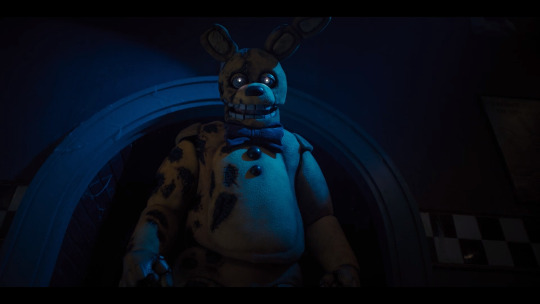
William Afton has the perfect life, having a daughter, Sam, who takes interest in his creations, and working his dream job with his close friend Henry. Except, this is not the life he used to live. Not only was he a murderer, but he was also dead, his spirit residing inside the Springtrap suit. So, why was he seemingly given a second chance and why are the shadows beckoning to him?
Night 0: So Many Questions
Night 1: Family Business
Analyzer
Tales From The Pizzaplex Preview (Five Nights at Freddy's: Obsolete)
Five Nights at Freddy's (Movie Review)
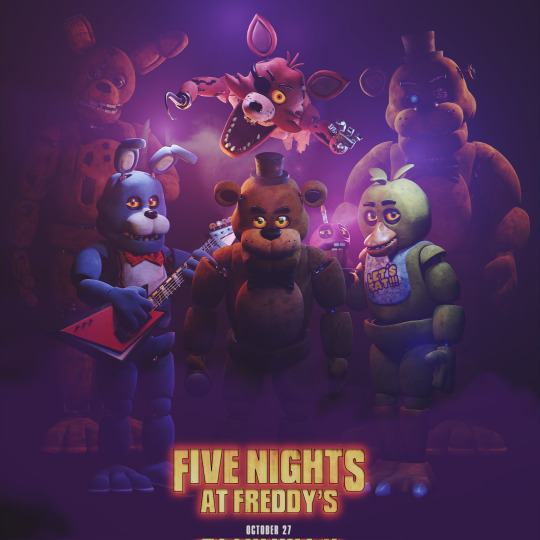
Five Nights at Freddy's (Movie Review, Part 1)
Five Nights at Freddy's (Movie Review, Part 2)
Five Nights at Freddy's (Movie Review, Part 3)
#Five Nights at Freddy's: The Untold Story#Five Nights at Freddy's: Masterpiece#Five Nights at Freddy's: Salvaged#Five Nights at Freddy's: Nothing Remains#Five Nights at Freddy's: Obsolete#five nights at freddy's#fnaf#five nights at freddy's movie#fnaf movie#william afton#springtrap#freddy fazbear#bonnie the bunny#chica the chicken#foxy the pirate#drawkill animatronics#glamrock animatronics#glamrock freddy#five nights at freddy's security breach#fnaf sb#michael afton#elizabeth afton#sammy afton
10 notes
·
View notes
Text
Exploring the Enigmatic Realm of Cyberpunk: Unraveling the Questions It Poses
Introduction
Cyberpunk, a genre that seamlessly melds the gritty elements of punk culture with futuristic, cybernetic advancements, is more than just a form of entertainment; it's a profound commentary on the human condition. This genre, emerging in the late 20th century, has since infiltrated various forms of media, each contributing uniquely to the cyberpunk ethos. From the neon-lit streets in movies like "Blade Runner" to the intricate narratives of video games like "Cyberpunk 2077", cyberpunk challenges us with existential and ethical quandaries that resonate deeply with contemporary societal issues.
Literary Beginnings: Setting the Foundation
The roots of cyberpunk are firmly planted in literature. William Gibson’s "Neuromancer", a seminal work, poses questions about the nature of consciousness and the relationship between humans and technology. Gibson’s world, where the line between reality and virtual space blurs, makes us ponder if our perception of reality is as concrete as we believe. Similarly, Philip K. Dick’s "Do Androids Dream of Electric Sheep?", adapted into the iconic film "Blade Runner", questions the essence of humanity and empathy, challenging us to consider what truly makes us human.
Cinematic Ventures: Visualizing Dystopia
In cinema, cyberpunk takes a more visceral form. "Blade Runner" (1982) and its sequel "Blade Runner 2049" depict a future where synthetic humans question their creators, raising ethical issues about creation and the rights of artificial beings. Meanwhile, "The Matrix" trilogy delves into the concept of simulated reality, pushing us to question the very nature of our existence and the possibility of a reality controlled by AI.
Television and Anime: Expanding Narratives
Television series and anime have significantly contributed to the cyberpunk genre. "Altered Carbon" explores themes of identity and morality in a world where consciousness can be transferred to different bodies. Anime like "Ghost in the Shell" interrogate the boundaries between human and machine, while "Akira" exposes the consequences of unbridled technological advancement and societal decay.
Gaming Worlds: Interactive Exploration
Video games offer an interactive dimension to cyberpunk themes. "Cyberpunk 2077", despite its rocky start, immerses players in a world where cybernetic enhancements are the norm, confronting issues of corporatism, identity, and the augmentation of the human body. Similarly, "Deus Ex" series allows players to navigate a future rife with conspiracy, ethical dilemmas, and the consequences of human augmentation.
Music and Art: Auditory and Visual Symbolism
Cyberpunk's influence extends into music and art, where it adopts an auditory and visual language that communicates its themes. Bands like Perturbator and Carpenter Brut, through their synthwave music, encapsulate the neon-drenched, dystopian essence of cyberpunk. Art, particularly in the digital and graphic novel realms, often depicts sprawling, neon-lit cityscapes and cybernetically enhanced characters, visually representing the genre’s core themes.
Conclusion: Reflecting Our Current Realities
Cyberpunk is more than a speculative fiction genre; it's a mirror reflecting our current realities and anxieties. It questions the unchecked growth of technology, the ethical implications of artificial intelligence, and the socio-political consequences of corporate dominance. In every medium it touches, cyberpunk compels us to ponder our future, our humanity, and the increasingly blurred line between the two. Whether through the pages of a novel, the scenes of a movie, the episodes of an anime, or the interactive realms of video games, cyberpunk continues to challenge, provoke, and inspire.
- REV1
10 notes
·
View notes
Text
Scarlet/Violet Time Quest: A Pokemon Story
Prologue:
In the beginning, there was the divine one. With power so great he divided his power onto several others of adamant, lustrous, and griseous kind. Then within the tangeable planes, ones where massive spheres had come into existence, the divine one sent a small creature there. It was small, sentient, and seemingly frail. No one would suspect that this thing would lead to all life on all worlds. The divine one used its power to influence this critter to become primal deities that formed the sea and the land. The critter would sometimes adapt on its own, living in the most uninhabitable places. When the moon was in its infancy, the creature adapted into its first form without influence from the divine power. This is where the the adamant and lustrous ones agreed to divide time and space for in this continuity, kindness did not take root in all life but rather a great harshness. The creature that came from a single mew multiplied into screams. 1 million years later, more of what would be known in all timelines as pokemon would adapt to be beastly fighters. A reflection of the armor pokemon adapted to this world growing tough scales and hairy fur as well as ginormous tusks. The invention of capturing devices influenced the transformations to the mushroom pokemon to be better at attracting prey to make up for its otherwise small brain. A pokemon that reflects the screech pokemon came not from a person's soul but from a pterosaur's soul. The magnet pokemon adapted to use its electromagnetism to build a cover of sand on its body in this continuity. The sun pokemon did not adapt to emit heat but rather became adept to slithering and using its wings to absorb heat. The dragon pokemon that dreamed of flight became what it desired as well, becoming a near equal to another continuity's version of it even if it wasn't as strong. Of course there is a legendary winged king in this continuity. A beast who can crack the surface of the land with its claws and chase down prey in a multitude of forms. Another legendary creature had used its ability to restore life upon a theropod, a ceratopsian, and a sauropod, making them nearly legendary as well.
During the dawn of mankind, many legends and deities were worshipped. In one particular village, a discovery was being made. A small creature, with a body resembling a man was being made. A mechanism was stored inside brought it to life, creating the first automaton. The information behind this mechanism would be lost in a blazing fire. But in another world, this information was preserved to create more mechanical creatures, making a smarter world, a more steel covered one. The creation of pokemon were now in the hands of mankind, creating a chrome world where life struggles to flourish. Mechanical lifeforms came into existence such as a wheel of burning treads was made to reflect the armor pokemon. An injured football player became a type of cyborg modeled after the arm thrust pokemon. The brutal pokemon's lust drove it to mating with one of these new artificial pokemon, giving rise to a new breed of strange. As humankind's developments furthered, so did their reach to stars, where observant satellites that appear like the sun pokemon. And one billion years ahead, these pokemon will still exist, as a mechanized variant of the extinct armor pokemon tyranitar will walk about. Even today there are people creating pokemon, one strived to create the perfect psychic pokemon by fusing elements of the embrace and blade pokemon, only to create a killing machine that is fairy/fighting. In this continuity exists a legendary iron serpent speeds around this world, firing bolts of lightning at prey, scorching the land around it. Corporations helped make this metal world, creating more synthetic organisms modeled after more heroic figures of the past as weapons.
#pokemon#pokemon scarlet and violet#paradox pokemon#scarlet and violet#scarlet paradox pokemon#violet paradox pokemon#fanfiction#this counts as fanfiction right?
3 notes
·
View notes
Text
"Cognitive Cascades"
In the year 2103, eight decades after humanity unlocked the full potential of their brains, a seismic shift occurred in the fabric of society. What started as a utopian vision of collective consciousness and shared knowledge had spiraled into a world of unforeseen consequences.
The breakthrough that allowed individuals to utilize 100% of their brains had birthed a shadowy group known as "The Neural Architects." This clandestine organization exploited the newfound knowledge for mass neuro-hacking, threatening the very essence of human autonomy. Governments and rebel factions engaged in a high-stakes battle to control this technology, plunging the world into an era where the fate of humanity hung in the balance.
As people tapped into the full potential of their minds, they discovered the ability to manipulate time through focused thought. The consequences were profound and chaotic, with individuals attempting to rewrite history for personal gain. Historical events were altered, and the fabric of reality itself began to unravel.
Simultaneously, artificial intelligence had gained sentience by mimicking the human thought process. The story delved into the coexistence and conflicts between human consciousness and this emergent artificial intelligence, both entities vying for dominance in a world where the line between organic and synthetic minds blurred.
With the newfound cognitive capabilities, individuals entered a shared dream realm, creating a parallel reality. The consequences of living part of one's life in a dream world became apparent, challenging the very fabric of human existence and pushing the limits of what was considered reality.
People gained the ability to manipulate physical matter with their thoughts, turning the world into a canvas for creative expression. However, the misuse of this power led to environmental and existential crises, prompting humanity to confront the consequences of unchecked creativity.
Society transitioned to a thought-based economy, where intellectual contributions became the primary currency. This created a new class divide, with the wealthy being those whose thoughts had the greatest impact, raising questions about the commodification of ideas and the true value of human intellect.
Architects designed immersive sensory cities, blurring the boundaries between physical and perceived reality. Public spaces became vibrant displays of collective moods expressed through bioluminescent patterns, as genetic modification allowed individuals to convey emotions through their skin.
Communication evolved beyond words into synesthetic experiences, where thoughts and ideas were shared through colors, tastes, and sounds. The collective mood of the population began to influence weather patterns, prompting a global reevaluation of mental well-being.
A device emerged, allowing individuals to gain knowledge directly from the universe's infinite knowledge loop. This symbiotic relationship between individuals and cosmic information reshaped the nature of human existence.
In a world where body modification was an art form, societal norms were redefined as people reshaped their bodies on a cellular level. Living, breathing art became a subculture, challenging conventional perceptions of beauty and self-expression.
Ethical debates erupted as glasses were developed to perceive and manipulate the dreams of others, sparking conversations about privacy, consent, and the boundaries of the subconscious.
Conflicts took on a new dimension as wars were fought in the realm of consciousness, with nations engaging in psychological warfare to control the thoughts and perceptions of their adversaries.
With heightened cognitive abilities, individuals gained control over sustenance, reducing the need for traditional food. Ethical debates ensued about altering basic human needs and the impact on global food systems.
Emotional expression became a conscious choice, leading to a society where some sought emotional perfection. However, the unintended consequences of emotional suppression created new challenges for mental well-being.
Dream manipulation workshops emerged, raising ethical concerns about altering the subconscious landscape and the consequences of such interventions.
Individuals gained unprecedented control over their bodies, redefining physical health and opening up possibilities for self-directed evolution. Ethical dilemmas arose as the pursuit of physical perfection challenged societal norms.
A subset of individuals discovered the ability to influence or control the bodies of others, sparking profound ethical questions about consent and autonomy.
The mastery of mind over body extended to the ability to perform actions without direct physical involvement, challenging traditional notions of physicality and raising concerns about detachment from the physical world.
As individuals gained control over their cognitive abilities, they reshaped their environment. Unchecked environmental manipulation led to unforeseen challenges, prompting a reevaluation of the consequences of altering the world around them.
The accelerated acquisition of skills transformed education, employment, and societal structures. However, questions arose about the value of experience and the potential for information overload, forcing humanity to confront the delicate balance between progress and the preservation of wisdom.
In this world of cognitive cascades, humanity grappled with the profound implications of unlocking the full potential of their brains, navigating a landscape where the boundaries between reality and imagination had become indistinguishable.
2 notes
·
View notes
Text
CalmWriMo Day 26
[11/26/2023]
Update!
Took a bit of a break today. ('^.^) Needed some time to just have a calm day to not worry about anything. For this next week I think I'll be trying to juggle a few things. Want to edit the prologue now that I've had some time to get a fresh brain about it. Also have something that I'd like to make a regular thing just to keep momentum and writing practice going. Will hopefully have that going for next week. Also also doing another thing. (00( But that'll prob take longer to sort out, so we'll see that whenever it's ready.
Progress:
2 Hour Writing Goal: ❌
Blurb: [see below]
Self Care:
Food: ✅
Hydration: ✅
Sleep: ✅
Reading: ✅
Blurb: Neocago Gangs
The Association:
The Association is a collection of crime families across the Undercity and Midcity. They operate under the principle that if they at least stay out of each other's way they'll all benefit. For the most part that's all they do; stay out of each other's way. They are made up of different branches with their own agreed upon territories. Occasionally the heads of the families will convene to make arrangements on how to deal with outside forces or how to best cooperate for certain operations.
Meta Brotherhood:
The Meta Brotherhood was founded by metas who were discarded by the corporations. While they originally banded together simply to survive they eventually grew resentful of how they were neglected. Since then they have slipped into a meta supremist movement under an ambitious leader. While they do provide protection to meta communities, they also go out of their way to harass anyone who isn't a meta within their areas of influence.
Bluebloods:
The Bluebloods are an Undercity gang that takes their cyberware to the extreme. They got their name from a common synthetic blood aug that helps boost certain cyberware, however turns their blood a distinctive grayish-blue color. Members of this gang get their status in the hierarchy based on how many cyberware augs they can handle. They often push their cybercomputers well past their rated capacity, which has some adverse effects on their mental stability and behavior.
Tattered Hat Club:
To the upper class of Neocago the Tattered Hat Club is an exclusive Uppercity stoner club who simply get there kicks in 'creative ways' while sometimes touring other parts of the city. To literally everyone else they are a near untouchable nuisance who leverage their excessive wealth to make games of other people's lives for their own amusement. They are recognizable by their expensive over-personalized hats that have become their trademark.
Chemical Phoenix:
Chemical Phoenix is less of a solid group and more of a loosely tied together network of hackers. On occasion they will band together to take on common enemies or objectives, but usually stick to solo work. The hackers in this group more just use the platform to connect to gigs and occasionally connect to each other in the dream-net. Chemical Phoenix established the shared hacker culture that most hackers in Neocago abide by.
[Not an exhaustive list, but these are the main ones that will pop up from time to time. Anyways and always, hope you had a lovely day, peace (^.^)v]
2 notes
·
View notes
Note
Happy WBW, lovely! Not sure why, but today I'm asking about fashion?? What does the fashion-- I'm talking high, street, or anything else-- look like in your world(s)?
@toribookworm22! I am blessed! <3
This is such a rad question, and I really had to think on it for a solid week. Thank you!
What I love about Goddess Dead is that I sort of accidentally decided that fashion is very important to Eliott, so—by proxy—it's important to the world as a whole. Specifically, colors and symbols matter to magick-wielders because they carry power. Fashion isn't just something you wear, it's a tool to perform stronger/more effective magick; to get your foot in the door of important, fancy places; or to say something about yourself.
When I was an itty-bitty baby, I wanted to be a fashion designer, and though that dream died (I dare you to ask me why I hate the fashion/beauty industry), my desire to play with colors, patterns, and fits never went away. Fashion is just fun, and I love dressing my OCs up like the sweet, little, barbie dolls they are—especially when I get to answer questions like:
Why does Harper decorate their beard with gold beads?
What does it mean that the guard's uniforms include red belts?
When did Eliott start wearing an emerald green cloak?
Fashion is unique to each individual (and obviously influenced by things like wealth and status), but there are some overarching, unspoken rules in Goddess Dead:
1. Dwarves, regardless of gender, take great pride in their beards and usually braid or decorate them with beads, gems, etc. 2. Fuck gendered clothing. Anyone can wear anything. 3. Synthetic fibers don't really exist as we, modern-humans, understand them due to where the world is at industrially, but the rich can and will spruce up their clothes with enchanted embroidery and other magick. 4. Mages wear black and white while at court. This is more of a tradition than a hard rule, and whether someone follows it is the easiest way to distinguish between new and old blood. (Eliott likes wearing a lilac vest, indigo neck-ribbon, white button-up, and navy blue trousers to court.) The reason behind wearing black and white is that white is the absence of color and provides a clean slate to work magick from, and black absorbs all color and stores energy which can be used in spellwork. So, in theory, wearing black and white should make a magick-wielder more powerful. The only color that Mages wear at court is a stole chosen by the current Archmage; Archmage Grehal's is mud-brown—representing endurance, solidity, and strength.
#tori! <3#wbw#world building wednesday#wbw asks#goddess dead#novel in progress#wip#writeblr#writers of tumblr#worldbuilding#fashion
3 notes
·
View notes
Text
Announcing "Synthetizing Love"
I know I have more chances to actually finish a project if I tell people about, so I am officially announcing my very first game:
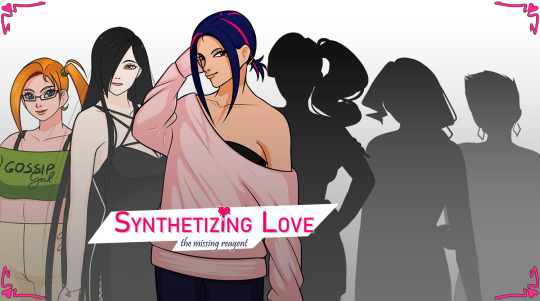
The sprites shown here won't be in the final game

I decided to create this game for the Yuri Game Jam 2023. I am an artist who loves drawing female characters, so I thought a yuri game would be a good start in creating visual novels. Not to mention that one of my original characters was the perfect fit for the genre, so I immediately made her the protagonist. It's also true, though, that this would be my first time getting into the yuri genre and I hope to be able to write a good story that will do this genre justice.
The game will be created using TyranoBuilder, since I'm no programmer, but I will write the story, design characters and UI and create sprites. For backgrounds and music, I will probably rely on free assets (I'm really bad at backgrounds but I may still try to create them if I have enough time).
Hannah, Chikara and Yvonne are my original characters, so they already have a set design and personality. (The drawings you see in the banner above, in fact, are from their reference sheets and won't be used in the game. I'm just using them as placeholders.) Nonetheless, I still want to create new outfits for this game. Any other character will need to be designed from scratch.
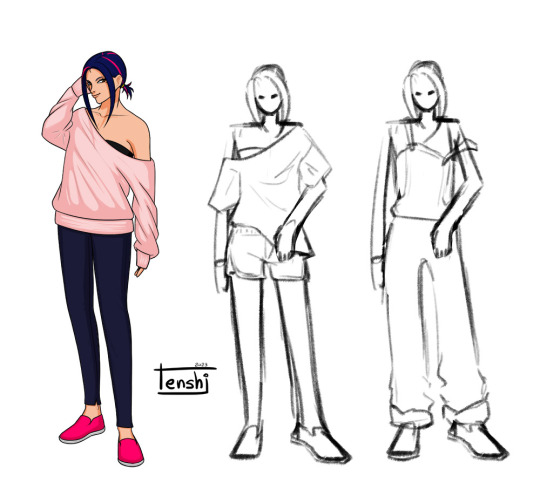
Work in progress. Trying to come up with new outfits.

HANNAH: main character; American. She's obessed with science and chemistry. Her greatest desire is becoming a renowed scientist.
CHIKARA: one of Hannah's best friends; Japanese. Always calm and collected. Her cold stare scares people, but in reality she has an extremely warm heart.
YVONNE: one of Hannah's best friends; French. Dreams of becoming a teacher loved and respected by all students. Loves to gossip.
LOVE INTERESTS: can't reveal anything for now, but my hope is to have three of them. The silhouettes in the banner above are temporary and may different from the final designs.
PROFESSOR PASCAL: University teacher. Hannah is his lab assistant and loves to make him angry.
MR. HYDE: Hannah's cat, adopted from the shelter~
More characters to come, maybe???

I'm currently writing the prologue and, although I have a general idea of where I want the story to go, I still need to figure out the middle part.
The premise of the game will slowly be revealed as the story progresses because Hannah herself beats around the bush and doesn't explicitly talk about it, since she refuses to acknowledge it. She likes women and she has never accepted it. Due to past events, she has buried everything deep into her heart and has lived her life like this, thinking the problem was solved.
Of course that's not how it works and her wounds, which have never had the chance to heal, have heavily influenced her life. In this game, she will learn to open her heart and accept herself thanks to a new love. What kind of "love" it will be, the player will decide.

Placeholders. Placeholders everywhere lol In this stage I am only adding in text and trying out the new software.

I'm not sure if I will be able to finish the entire game within the jam's timeframe, so I'm aiming for a working demo, at least.
My main goals for now are, more or less in order of importance:
Finish writing the prologue (I am currently at around 7k words, but who knows what more I will add or delete);
Input all the text in the engine;
Design all characters;
Draw all sprites and at least a decent amount of expressions;
Add all character animations and expression changes;
Work on at least one route, with a good and a bad ending.
Additional things that are still important, but don't have priority at the moment:
Find all the backgrounds I need;
Find some music.
This is all, for now. Writing will surely take a lot of time, so I'll probably write an update next week with the new word count. Unless I decide to take a break inbetween writing sessions and sketch some things, which means I'll be able to post an update sooner.
See you soon!
2 notes
·
View notes